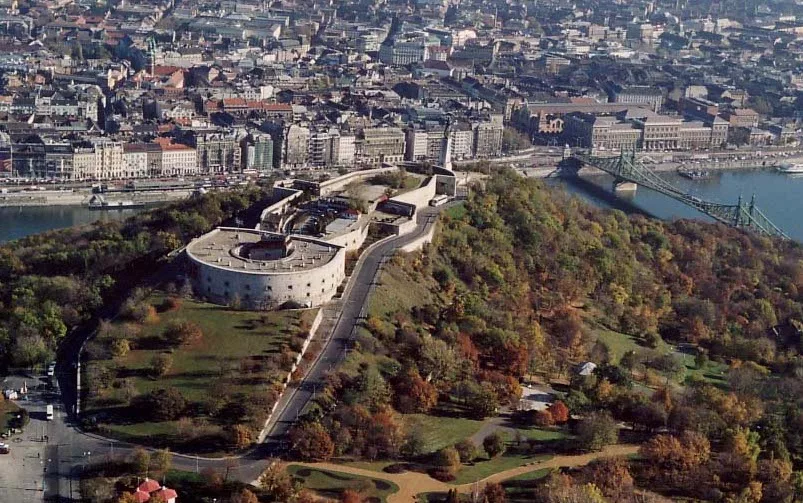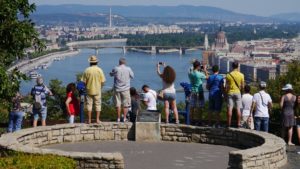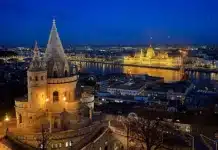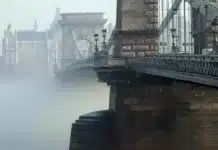Perched on Gellért Hill, the Citadel of Budapest is much more than just a fortress. A symbol of the city’s resilience, it offers breathtaking views of Budapest and a fascinating insight into its eventful past.
The Citadel of Budapest is located at the top of Gellért Hill, on the right bank of the Danube, in the southern part of the Hungarian capital. This strategic position makes it an ideal vantage point offering spectacular views of the city, the Danube and the surrounding area.
Origins and history of the Budapest Citadel
The origins of the Citadel of Budapest date back to the 19th century, a period marked by conflicts and revolutions in Europe. Its construction was ordered by the Austrian Emperor Joseph I after the Hungarian Revolution of 1848, with the aim of consolidating Austrian control over the country and suppressing any future rebellions.
Built between 1850 and 1854, the Budapest Citadel was designed in an imperial military style, overlooking the city from Gellért Hill. Its strategic position made it an ideal surveillance post, allowing movements in Budapest and along the Danube River to be monitored and controlled. However, despite being built for control and deterrence purposes, the Citadel was never used for major military purposes. Instead, over the decades it has been a passive witness to Budapest’s troubled history, surviving major political and social changes.
During the 20th century, the Budapest Citadel was the scene of various events, notably during the two World Wars and the Cold War period. After the Second World War, it was used as a military barracks by the Soviets, symbolising the occupation of Hungary by the Eastern bloc.
Today, the Citadel is a symbol of freedom regained for Hungarians.
An impressive symbol of military architecture and freedom
The architecture of the Budapest Citadel can be defined as imposing, functional and strategic. It features elements typical of military fortresses, with massive walls, bastions and watchtowers. The star-shaped layout of the ramparts reinforces its defence, while its buildings are designed to fulfil specific military functions, such as ammunition storage or soldiers’ quarters.
Although its architecture is primarily focused on functionality and security, the Budapest Citadel also features aesthetic elements, notably the Statue of Liberty that crowns its summit:
The Statue of Liberty that sits proudly atop Budapest’s Citadel is much more than just a sculpture. Erected in 1947 to commemorate the liberation of Hungary by the Allied forces at the end of the Second World War, this imposing female figure embodies the spirit of freedom and resistance.
The 14-metre-high statue depicts a woman holding a palm in one hand and a broken sword in the other, symbolisingvictory and peace restored after years of conflict. Its location on Gellért Hill offers a breathtaking view of the city of Budapest and the Danube, making the Statue of Liberty an emblematic landmark of the Hungarian capital.
During the Communist period, the statue was transformed into a symbol of Soviet oppression, with an inscription added to the feet of the statue, declaring “In memory of the heroic Soviet fighters who gave their lives for the liberation of Budapest in 1945.” After the fall of the Communist regime in 1989, this inscription was removed, restoring the statue to its original role as a symbol of freedom and resistance.
Today, the Citadel’s Statue of Liberty remains a poignant testament to Budapest’s turbulent history and the ongoing struggle for freedom. It reminds visitors of the precious value of freedom and the importance of remaining vigilant in the face of all forms of oppression.
Legends and anecdotes
The Ghost of the Citadel: according to local legend, the Citadel is haunted by the spirit of a medieval soldier. It is said that his ghost wanders the dark corridors of the fortress, eternally watching over its walls.
The Hidden Treasure: an ancient legend has it that a hidden treasure lies somewhere in the underground passages of the Citadel. Many treasure hunters have tried to find it, but to date it has remained elusive.
The Forgotten Prisoner: deep in the dungeons of the Citadel, a forgotten prisoner is said to have been locked up centuries ago. Some visitors claim to have heard his lamentations in the dark corridors of the fortress.
These legends and anecdotes add a touch of mystery and fascination to the Budapest Citadel, enriching its already rich history.
Panoramic views of the Budapest Citadel

The views from the Budapest Citadel are among the most spectacular in the city, offering breathtaking panoramas of Budapest and the majestic Danube River.
From the top of the Citadel, you can admire the imposing silhouette of the Hungarian Parliament, whose architectural beauty is amplified by the reflection of its lights on the waters of the Danube.
You can also contemplate the historic buildings of Pest along the Danube and the majestic Chain Bridge, the oldest bridge in Budapest, an emblematic symbol of the capital and magnificently illuminated at night.
The panoramic view on the Buda side also extends to the castle district and the Gellért baths with their majestic domes.
Watch this video on the Budapest Citadel:
Visit the Citadel of Budapest
How do I get to the Budapest Citadel?
The easiest and cheapest way to get to the Citadel is to use Budapest’s public transport system. You can take the number 27 bus from Budapest city centre, which will drop you off near the entrance to the Citadel.
You can also use the Budapest sightseeing bus, which offers guided tours with stops at the Citadel.
Visiting times
The Budapest Citadel is a public outdoor site, so it is accessible at all times, 24 hours a day, 7 days a week. There is no entrance fee.
Visitors can visit the Citadel and enjoy its panoramic views of Budapest at any time of the day or night, with no time restrictions.
However, it is important to note that some of the Citadel’s specific facilities, such as souvenir shops or food outlets, may have specific opening times.
Address: Budapest Citadel, Citadella sétány 1, 1118, Pest – map –















